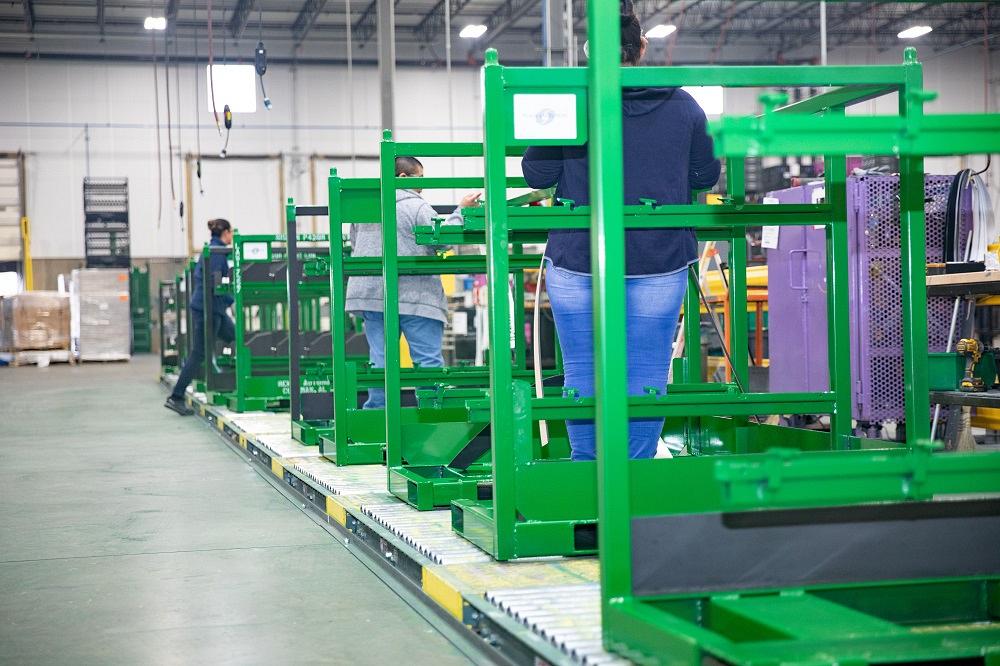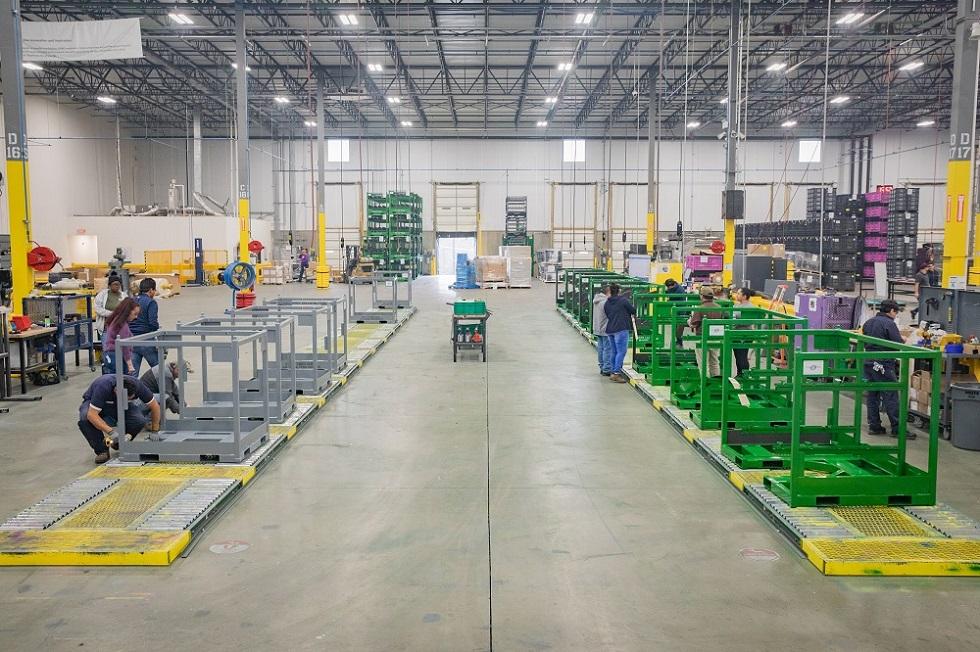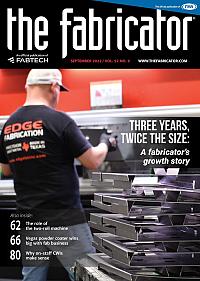Senior Editor
- FMA
- The Fabricator
- FABTECH
- Canadian Metalworking
Categories
- Additive Manufacturing
- Aluminum Welding
- Arc Welding
- Assembly and Joining
- Automation and Robotics
- Bending and Forming
- Consumables
- Cutting and Weld Prep
- Electric Vehicles
- En Español
- Finishing
- Hydroforming
- Laser Cutting
- Laser Welding
- Machining
- Manufacturing Software
- Materials Handling
- Metals/Materials
- Oxyfuel Cutting
- Plasma Cutting
- Power Tools
- Punching and Other Holemaking
- Roll Forming
- Safety
- Sawing
- Shearing
- Shop Management
- Testing and Measuring
- Tube and Pipe Fabrication
- Tube and Pipe Production
- Waterjet Cutting
Industry Directory
Webcasts
Podcasts
FAB 40
Advertise
Subscribe
Account Login
Search
The rise of returnable, reusable packaging to help manufacturing's reshoring efforts
Logistics, material handling, and packaging company fabricates returnable steel racks, containers
- By Tim Heston
- September 30, 2022
- Article
- Materials Handling
Most scientists quickly point out that although they call COVID-19 the novel coronavirus, pandemics aren’t novel at all. The global economy is quite novel, though, especially when it comes to the velocity and sophistication of global trade—a system built without a pandemic in mind.
Reshoring initiatives are being pushed into high gear; supply chains are being reshaped, at least where practical. Market consolidation has added some inertia to the reshaping; if, say, a fabricator can get a certain hydraulic component only from a certain supplier, there’s not much that can be done about it, at least in the near term. But for sheet metal and plate parts, supply chains can indeed be altered. More OEMs are looking for domestic partners and, with that, new ways of transporting parts to their final assembly plants.
Within a designated area in a Greenville, S.C., fabrication facility, a technician starts an ASTM shake test on something that has become central to that domestic supply chain: returnable, reusable packaging. These include steel racks, containers, and (if required) the rigid and fabric dunnage inside. How they’re designed and fabricated have broad implications about the domestic supply chain.
The Science of Returnable Packaging
“We’re modeling how a container fully packed with parts would perform on a U.S. highway,” said Kacie Freeberg, senior director, industrial, at ORBIS, describing why the technician is performing that shake test. Based in Wisconsin, ORBIS has various locations dedicated to manufacturing returnable packaging, including a metal fabrication plant in Greenville, which the company acquired when it purchased Response Packaging in 2018.
ORBIS has deep roots in the packaging world. Its parent company, Menasha Corp., established itself in the material handling arena more than 150 years ago when its turned wood products were seen carrying materials in bakeries, laundries, hospitals, and factories.
In the 1990s, the organization created its ORBIS subsidiary to focus on plastic and fabric returnable packaging products, and the purchase of Response Packaging brought ORBIS into the metal returnable market. Today, the company operates two metal fabrication facilities, one in Mexico (through joint venture) and one in Greenville. The plants fabricate the metal containers and racking and incorporate rigid or fabric dunnage.
That shake test in the South Carolina plant occurs away from the band saws, the tube laser, and the welding booths that fabricate custom returnable racks and containers, mainly for the automotive supply chain. And it’s not just an afterthought. The ASTM test simulates where a streamlined supply chain literally hits the road, showing how a customized returnable packaging reacts to the bumping and jostling of road travel.
“The test itself uses various frequencies and speeds,” Freeberg said. “It allows us to see if there’s any rubbing. If, say, a [rack or container] holds just one large part, it might not be so critical. But if you’re packing, say, a number of side body panels, one visual flaw on each part can reject an entire truckload of goods. We need to make sure these containers work as designed for the life of the program.”
Highway travel is just one variable. Designers take stop-and-start city travel into account too and, especially, the jostling created when fork truck drivers and material handlers move parts off trucks and to final assembly. How they’re moved matters, as well as how parts are presented to the assembly line.
The frequency of this loading and unloading also matter. Mike Costello, ORBIS’ product manager of metal solutions, described a common misconception about packaging and travel distances. “We’re seeing supply bases become more and more localized,” he said, adding that small, frequent deliveries can introduce a host of efficiencies for both suppliers and OEMs. “But there’s a misnomer out there that shorter travel distances means lighter packaging. In the world of returnables, a short travel distance means that the rack or tote will be used at a higher frequency.
“Early in my career [at another manufacturer], I recall we had to ship bumpers a short distance, and we thought about making the returnable packaging out of lighter, thinner steel,” Costello continued. “But those racks started breaking down sooner than they should have. When we dug into it, we found they were being moved 14 times a day.” Such frequent deliveries might represent the epitome of just-in-time manufacturing, with parts being “drip fed” between the supplier and OEM, but all that loading and unloading did a number on the returnable steel racks.
Designing Returnables That Work
Back at the Greenville plant, a worker in powder coating places what looks to be a large box inside a container. It’s a masking template designed to handle a variety of container sizes. It turns out that this container is painted only on the outside, not on the inside, to avoid contaminating the products it will carry.
Freeberg explained that each application presents myriad variables designers consider, and the process begins when sales engineers visit an OEM to study the operation. Since the acquisition of Response Packaging, ORBIS engineers have been able to consider the whole range of packaging alternatives. “This allows us to provide an unbiased solution,” Freeberg said.
Heavier parts tend to work well with steel returnables, lighter parts with plastic returnables, though weight is just one factor. Heavy parts transported frequently over short distances might work especially well with steel, considering the durability requirements from frequent loading and maneuvering.
“We have a technical sales team, each of whom operate as almost a hybrid between a designer and an industrial engineer,” Freeberg said. “They walk customers’ floor to discover the best way to pack a part, based on how it moves through the customer’s building. We go through a wide range of variables. So many things need to be taken into consideration when it comes to packaging and delivering parts.”
How frequently are parts delivered, and in what batch sizes? Who interacts with the containers: robots, humans, or both? Do material handlers move the products with hand trucks, fork trucks, carts, cranes, or a combination of methods? Will the container or rack require wheels? Can a returnable container or rack present parts to material handlers in a better way? What rigid or fabric dunnage might be required? What about error-proofing—that is, being able to orient a part only in a certain (correct) way? What visual cues could help material handlers (or even automated systems) identify what returnable container goes where and show how to safely handle the container or rack?
Freeberg pointed again to the manual paint line in the Greenville facility. She explained that they often paint pockets of different colors on containers to show a material handler where and how to safely move a returnable rack or bin, along with other visual cues that help workers load and unload parts.
With all these data points in hand, the design team uses specialized software to calculate how many parts can be packaged within a given footprint, maximizing the available space. “Squeezing one more part in a given space can be a very big deal in terms of package spending and also freight [costs],” Freeberg said, adding that simply reorienting a part in a certain way can make a huge difference in packaging density.
After this comes prototyping to ensure parts fit as intended. Usually, the frame of the rack doesn’t change, but the way a part is cradled and secured inside might. After all this, it’s on to the production phase.
‘Did We Win the Day?’
Although ORBIS’ South Carolina plant specializes in returnable containers and racks, its 200 employees work in an engineer- and make-to-order operation. A plasma and flat-sheet laser cuts sheets to size, and a tube laser cuts round and square tubes, complete with tab-and-notch designs that simplify downstream fixturing, welding, and assembly. The laser also cuts the pockets that accept hand and lift truck forks. “The tube laser really helps us from a precision standpoint,” Freeberg said. “It eliminated all sorts of weld points, and we’re not manually cutting [the fork pockets].”
Component fabrication feeds a parts supermarket. From there, weld lines pull what they need to fulfill orders, and like in typical custom fabrication, job packets or travelers follow work as it flows through the plant. The plant also has target cycle times for each process step. Although ORBIS is a custom operation, the upstream laser cutting and sawing processes have less variation. “We’ve done time studies processing components across our product mix,” Freeberg said, “and we incorporate steps like material changes and other elements. Even though we are a custom operation, the [cycle-time target] numbers stay fairly consistent.”
As products move downstream, the target cycle times become more job-specific. “For instance, to establish the amount of welding per hour, we work with the shift supervisor to determine an hourly goal,” Freeberg said.
From all this, the company establishes throughput goals for each hour and each shift. “Did we win the hour? Did we win the shift? Did they win the day? Winning hours translates into winning days, weeks, and months,” Freeberg explained, “to achieve the capacity and throughput we’re looking for to ensure we meet customer commitments.”
The Road Ahead for Returnable Packaging
The North American automotive industry began making the transition to returnable packaging in the 1990s. “They slowly made the transition, and now it’s pretty much a converted market,” Freeberg said, adding that as reshoring and the continued push toward domestic manufacturing continues, the demand for returnables continues to rise.
“The average age of a vehicle on the road is approaching 12 years,” Freeberg said. So, despite short-term challenges, “we expect demand to continue to stay high.” Sustainability remains a priority, which is good news for returnable packaging. “Sustainability isn’t just something that’s nice to say anymore. It’s become a core objective for our customers.”
With increased demand might come new ways of planning and integrating returnable packages into the supply chain. “We’re exploring augmented reality and using some level of vision system,” Freeberg explained, “overlaying the packaging itself with a model of [what’s being packaged] as well as the system it’s going into.”
From a manufacturer’s perspective, secure packaging couldn’t be more important. The products being shipped are full of value; they’ve been laser cut, formed, welded, coated, and assembled. If they arrive damaged, all that added value goes out the window. Fabricators like ORBIS work to make sure that doesn’t happen.
About the Author

Tim Heston
2135 Point Blvd
Elgin, IL 60123
815-381-1314
Tim Heston, The Fabricator's senior editor, has covered the metal fabrication industry since 1998, starting his career at the American Welding Society's Welding Journal. Since then he has covered the full range of metal fabrication processes, from stamping, bending, and cutting to grinding and polishing. He joined The Fabricator's staff in October 2007.
subscribe now

The Fabricator is North America's leading magazine for the metal forming and fabricating industry. The magazine delivers the news, technical articles, and case histories that enable fabricators to do their jobs more efficiently. The Fabricator has served the industry since 1970.
start your free subscription- Stay connected from anywhere

Easily access valuable industry resources now with full access to the digital edition of The Fabricator.

Easily access valuable industry resources now with full access to the digital edition of The Welder.

Easily access valuable industry resources now with full access to the digital edition of The Tube and Pipe Journal.
- Podcasting
- Podcast:
- The Fabricator Podcast
- Published:
- 04/16/2024
- Running Time:
- 63:29
In this episode of The Fabricator Podcast, Caleb Chamberlain, co-founder and CEO of OSH Cut, discusses his company’s...
- Trending Articles
AI, machine learning, and the future of metal fabrication

Employee ownership: The best way to ensure engagement

Dynamic Metal blossoms with each passing year

Steel industry reacts to Nucor’s new weekly published HRC price

Metal fabrication management: A guide for new supervisors

- Industry Events
16th Annual Safety Conference
- April 30 - May 1, 2024
- Elgin,
Pipe and Tube Conference
- May 21 - 22, 2024
- Omaha, NE
World-Class Roll Forming Workshop
- June 5 - 6, 2024
- Louisville, KY
Advanced Laser Application Workshop
- June 25 - 27, 2024
- Novi, MI




























